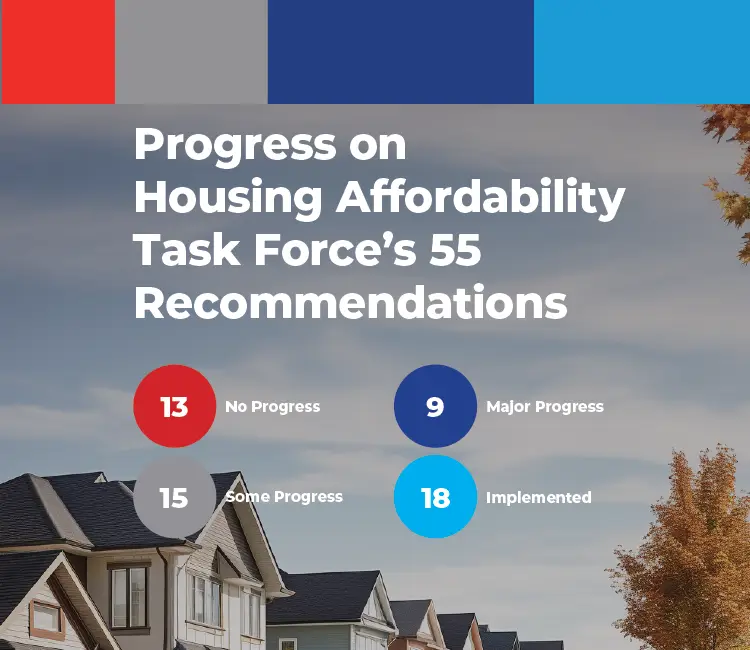
Log in as a...
New!
We’ve partnered with CREA to help improve your member experience and give your information the best security possible.
Click Here for additional instructions on the member login.
You will be returned to OREA once you have successfully logged in.
Advocacy
Analysis of Ontario’s Efforts To Boost Housing Supply
The Ontario Government has set an ambitious goal of adding 1.5 million homes to the province’s housing stock by 2031. This goal reflects the urgent need to solve Ontario’s housing affordability crisis – one ultimately driven by too few homes, for too many people. While notable progress has been made since 2018, more can and must be done to ensure Ontarians have the homes they need today, and in the future. With this paper, OREA hopes to point the best way forward.
DOWNLOAD REPORT Email your MPP
In 2024, the Ontario Government should return its focus to the most impactful policies, with the most long-term benefit to housing supply in Ontario. Based on progress to date, OREA has outlined a path forward with 10 action items that are critical to increasing housing supply and improving affordability across the province.
WHERE WE’RE AT

WHERE WE’RE AT
In pursuit of getting more homes built, the Ontario Government has made sweeping changes to the province’s planning and development regime since 2018, through four pro-housing pieces of legislation.
A major step—and driver of many recent changes—was to create the Housing Affordability Task Force, which provided 55 recommendations in its 2022 report. The government accepted this comprehensive report and its ambitious recommendations. Since then, the Ontario Government has made noteworthy progress towards implementation, with 76% of the Task Force recommendations fully implemented or in progress.
However, challenges stemming from shortages of builders, skilled tradespeople, and short-term land supply is compounded by red tape and a widespread bias against development. Further, external factors like higher interest rates and construction financing costs have slowed positive progress on new developments, and risk slowing the pace of growth that has come from efforts to date.
In fact, the Government’s own projections for the next few years fall short of the needed 150,000 per year to meet that ambitious target of 1.5 million new homes.
Take Action
THREE KEY SOLUTIONS
Ontario is a fantastic place to live, grow, conduct business, and raise a family; yet many people are losing hope that they will ever be able to afford a home. The high cost of ownership and lack of supply is forcing many families to leave Ontario and move to other provinces to simply find an affordable place to live.
We must change this outlook to give Ontario families hope. Unless dramatic steps are taken to increase supply and improve affordability, Ontario’s economic and social future are at stake.
1
ALLOW WATER AND WASTEWATER SERVICES TO BE PROVIDED THROUGH A MUNICIPAL SERVICES CORPORATION
The Provincial government should work with municipalities to develop and implement a municipal services corporation utility model for water and wastewater.
This would allow the municipal corporation to borrow and amortize costs among customers, instead of using development charges – eliminating unnecessary costs on housing developments, while funding these important investments in a transparent, public way.
This is a crucial recommendation for long-term supply and affordability, as service-ready land is a key requirement for housing development, and implementation should be a priority for the Ontario Government this year.
2
MODERNIZING ZONING TO SUPPORT COMMERCIAL-TO-RESIDENTIAL CONVERSIONS AND GREATER DENSITY ALONG TRANSIT CORRIDORS
In many regions of Ontario, zoning rules restrict development, making it difficult to gently increase density along transit corridors and major transit hubs; convert commercial properties to residential; and to build “missing middle” housing where aging single-family homes currently stand.
To ensure this happens, the Government of Ontario must modernize provincial zoning by legislating commercial-to-residential conversions, overriding and local bylaws prohibiting this conversion; rezoning all land along transit corridors as mixed commercial and residential use; and removing minimum parking requirements on any streets utilized by public transit.
Modernized, as-of-right zoning near transit would allow for greater density around transit corridors and hubs, increasing the supply of housing in urban areas.
3
ELIMINATE EXCLUSIONARY ZONING
In many regions of Ontario, zoning rules restrict the development of “middle housing” such as low-rise apartments, duplexes and townhomes. All thriving communities need a mix of housing so that families can find homes that meet their needs at prices that they can afford.
Encouragingly, many municipalities – including Toronto, Guelph, and London – have pro-actively changed their zoning rules to allow up to four units per lot as-of-right, allowing missing housing to be developed without being hampered by red tape and lengthy approvals.
The Ontario Government should make this a provincial policy by implementing land use changes to end exclusionary zoning across Ontario – a step it could take in its next housing supply legislation.
BOLD ACTION BUILDS HOMES

BOLD ACTION BUILDS HOMES
Now is not the time to back down: the Ontario Government must continue to stand up against red tape and municipal NIMBYism, keeping its foot on the gas when it comes to increasing housing supply. There is still a long road ahead to get more shovels in the ground and bring new homes to market.
All 10 action items outlined in this report are critical to ensuring Ontario continues to create future generations of homeowners. Together, they would provide more resources for projects and infrastructure that enable growth, improve planning consistency, help ensure adequate infrastructure is in place, address short-term land needs, and improve affordability across the province.
10 ACTION ITEMS TO INCREASE SUPPLY
Building on the Task Force’s initial recommendations, OREA has outlined 10 action items for the Ontario Government to take in 2024 that will have a significant and long-lasting impact on Ontario’s housing supply crisis: